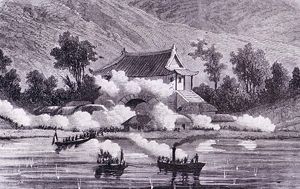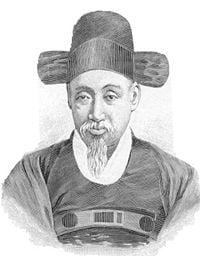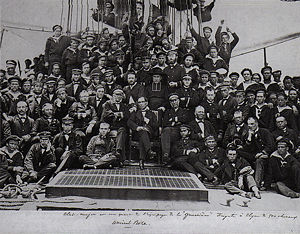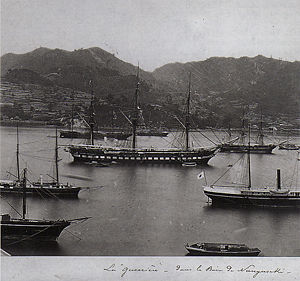French Campaign against Korea, 1866
| French campaign against Korea, 1866 (The byeong-in yang-yo) | |||||||||
|---|---|---|---|---|---|---|---|---|---|
 | |||||||||
| |||||||||
| Combatants | |||||||||
| Joseon Dynasty Korea |
France | ||||||||
| Commanders | |||||||||
| Korea: King Gojong Daewongun |
France: Pierre-Gustave Roze | ||||||||
| Strength | |||||||||
| Korea: unknown |
France: 150 | ||||||||
| Casualties | |||||||||
| Korea: Unknown |
France: 10 | ||||||||
| French Campaign against Korea, 1866 | ||||||||
|---|---|---|---|---|---|---|---|---|
|
The French campaign against Korea of 1866 is also known as Byeonginyangyo (Korean: 병인양요, Western Disturbance of the byeong-in year (1866)).
Byeonginyangyo refers to the French occupation of Ganghwa Island in retaliation for the execution of French Jesuit priests by the Korean ruler Daewongun. The campaign, the first armed encounter between Korea and a western power, lasted nearly six weeks. the French withdrew, leaving the Korean government with a false sence of security, leading the Korean throne to believe they could withstand imperialistic designs of their neighbors without modernizing.
Background
Though Joseon Dynasty Korea maintained a policy of strict segregation from the outside world (save for tribute intercourse with China and occasional trading with Japan through Tsushima), it did not succeed entirely in sealing itself off from foreign contact. Catholic missionaires had begun to show an interest in Korea as early as the 16th century with their arrival in China and Japan. Through Korean tribute missions to the Qing court in the 18th century, foreign ideas, including Christianity, began to enter Korea and by the late 18th century Korea had its first native Christians. However it was only in the mid 19th century that the first western Catholic missionaries began to enter Korea. This was done by stealth, either via the Korean border with Manchuria or the Yellow Sea. These French Jesuits arrived in Korea in the 1840s to proselytize to a growing Korean flock. Bishop Siméon-François Berneux, appointed in 1856 as head of the infant Korean Catholic church, estimated in 1859 that the number of Korean faithful had reached nearly 17,000.[1]

At first the Korean court turned a blind eye to such incursions. This attitude changed abruptly, however, with the enthronement of King Gojong in 1864. By Korean tradition the regency in the case of a minority would go to the ranking dowager queen, in this case the fiercely conservative mother of the previous crown prince, who had died before he could ascend the throne. The new king’s father, Yi Ha-ung, a wily and ambitious man in his early forties, was given the traditional title of the unreigning father of a king: Daewongun, or “Prince of the Great Court.” Though the Daewongun’s authority at court was not official, stemming in fact from the traditional imperative in Confucian societies for sons to obey their fathers, he quickly seized the initiative and began to control state policy. He became one of the most effective and forceful leaders of the 500 year old Joseon dynasty. With the aged dowager regent’s blessing, the Daewongun set out upon a dual campaign of both strengthening central authority Korean isolation from the disintegrating traditional order outside its borders. By the time the Daewongun assumed de facto control of the government in 1864 there were twelve French Jesuit priests living and preaching illicitly in Korea and an estimated 23,000 native Korean converts.[2]

In January, 1866 Russian ships appeared on the east coast of Korea demanding trading and residency rights in what seemed an echo of the demands made on China by other western powers. Native Korean Christians, with connections at court, saw in this an opportunity to advance their cause and suggested an alliance between France and Korea to repel the Russian advances, suggesting further that this alliance could be negotiated through Bishop Berneux. The Daewongun seemed open to this idea, though it is uncertain whether this was ruse to bring the head of the Korean Catholic Church out of his hiding place. Berneux was summoned to the capital but upon his arrival in February 1866 he was seized and executed. A roundup then began of the other French Catholic priests and native converts.
Several factors contributed to the Daewongun‘s decision to crack down on the Catholics. Perhaps the most obvious was the lesson provided by China, which had apparently reaped nothing but hardship and humiliation from its dealing with the western powers, seen most recently in its disastrous defeat during the Second Opium War. No doubt also fresh in the Daewongun‘s mind was the example of the Taiping Rebellion in China, which had been infused with western Christian doctrines. 1865 had seen poor harvests in Korea as well as social unrest, which may have contributed to a heightened sensitivity to the foreign creed. The crackdown may also have been related to attempts to combat factional cliques at court, where Christianity had made some inroads.
As a result of the Korean dragnet all but three of the dozen French missionaries were captured and executed. An untold number of Korean Catholics also met their end (estimations run around 10,000),[4] many being executed a place called Jeoldu-san in Seoul on the banks of the Han River. In late June 1866 one of the three surviving French missionaires, Father Felix-Claire Ridel, managed to escape via a fishing vessel and make his way to Tianjin, China in early July 1866. Fortuitously in Tianjin at the time of Ridel‘s arrival was the commander of the French Far Eastern Squadron, Rear Admiral Pierre-Gustave Roze. Hearing of the massacre and the affront to French national honor, Roze determined to launch a punitive expedition. In this he was strongly supported by the acting French consul in Peking, Henry de Bellonet.
On the French side, there were also compelling reasons behind the decision to launch a punitive expedition. These had to do with increasing violence against Christian missionaires and converts in the Chinese interior, which after the Second Opium War in 1860 had been opened up to westerners. As Korea was a nominal vassal of China, the massacre of westerners and Christians in Korea was seen by diplomatic and military authorities in the context of anti western behavior in China. Many believed a firm response to such acts of violence was necessary to maintain national prestige and authority. While the acting French consul in Peking took up a diplomatic iniative with Chinese authorities, Rear Admiral Roze made his own military preparations for a campaign against Korea.
Preliminaries (18 September-3 October, 1866)
Though the French diplomatic and naval authorities in China were eager to launch an expedition, they were stymied by the almost utter absence of any detailed information on Korea, including any navigational charts. Prior to the actual expedition Rear Admiral Roze decided to undertake a smaller surveying expedition along the Korean coast, especially along the waterway leading to the Korean capital of Seoul. This was done in late September and early October 1866. These preliminaries resulted in some rudimentary navigational charts of the waters around Ganghwa Island and the Han River leading to Seoul. The treacherous nature of these waters, however, also convinced Roze that any movement against the fortified Korean capital with his limited numbers and large hulled vessels was impossible. Instead he opted to seize and occupy Ganghwa Island, which commanded the entrance to the Han River, in the hopes of blockading the waterway to the capital during the important harvest season and thus forcing demands and reparitions on the Korean court.
The nature these demands were to take was never fully determined. In Peking the French consul Bellonet had made outrageous (and as it turned out unofficial) demands that the Korean monarch forfeit his crown and cede sovereignty to France. Such a stance was not in keeping with the more circumspect goals of Rear Admiral Roze, who hoped only to force reparitions. In any case, the demands of Bellonet were never officially endorsed by the French government of Napoleon III, and for his importunate blusterings he would later be severely reprimanded.[5]
Expedition (11 October-12 November, 1866)
On October 11th, Admiral Roze left Tchefou with the frigate La Guerrière, two avisos, two gunboats and a corvette. A group of 170 French marines landed on Ganghwa island and took the fortress which controlled the Han river. Soon the French offensive was met with stiff resistance from the troops of General Yi Yong-Hui, to whom Roze sent several letters asking for reparation, without success. The French continued bombarding the area, and then sailed up the Han river towards Seoul. The French marines managed to seize several fortified positions, as well as booty such as flags, cannons, 8.000 muskets, 20 boxes of silver ingots, and various lacquer works, jades, manuscripts and paintings.
Roze then sent a new letter, asking for the release of two missionaries who were still imprisoned. With no answer coming, on November 11th, Roze decided to bombard the palace and the adjoining official buildings. Soon, the two missionaries were released.[6]
Considering he had obtained satisfaction, Roze left Seoul and sailed down the Han river. 24 hours later, order was given to leave the country, and to destroy everything possible. Roze felt that with his limited means he could not do much more, but that his actions would have a dissuasion effect for the Korean government:
- "The expedition I just accomplished, however modest as it is, may have prepared the ground for a more serious one if deemed necessary,... The expedition deeply shocked the Korean Nation, by showing her claimed invulnerability was but an illusion. Lastly, the destruction of one of the avenues of Seoul, and the considerable losses suffered by the Korean government should render it more cautious in the future. The objective I had fixed to myself is thus fully accomplished, and the murder of our missionaries has been avenged." November 15th report by Admiral Roze[7]
The European residents in China considered that the results of the expedition were minimal and demanded a larger expedition for the following Spring, but this never happened.
After this expedition Roze and his fleet went to Japan, where they were able to welcome the first French Military Mission to Japan (1867-1868) in the harbour of Yokohama on January 13th, 1867.
Epilogue
Slightly later, in August 1867, an American ship General Sherman foundered on the coast of Korea. Some of the sailors were massacred, but the United States could not obtain reparations. The United States offered to France to mount a combined operation, but the project was abandoned due to the relatively low interest for Korea at that time. An intervention happened much later, in 1871, with the United States Korean expedition.
The Korean government would finally agree to open the country in 1877 only, when a large fleet of the Imperial Japanese Navy was sent under the orders of Kuroda Kiyotaka, leading to the Treaty of Ganghwa.
Aftermath
ReferencesISBN links support NWE through referral fees
- ↑ Dallet, 452.
- ↑ Kane (1999), 2.
- ↑ Source
- ↑ "It is estimated than 10,000 were killed within a few months" Source
- ↑ Kane (1999), 20.
- ↑ "Le résultat est immédiat: les deux missionnaires sont remis à l'Amiral.," in Léon Rochotte "La Corée 5.000 ans d'Histoire en raccourci" Source
- ↑ "L'expédition que je viens de faire , si modeste qu'elle soit, en aura préparé une plus sérieuse si elle est jugée nécessaire,....Elle aura d'ailleurs profondément frappé l'esprit de la Nation Coréenne en lui prouvant que sa prétendue invulnérabilité n'était que chimérique. Enfin la destruction d'un des boulevards de Seoul et la perte considérable que nous avons fait éprouver au gouvernement coréen ne peuvent manquer de le rendre plus circonspect. Le but que je m'étais fixé est donc complètement rempli et le meurtre de nos missionnaires a été vengé" Source
Sources
- Choe, Chin Young. The Rule of the Taewŏn’gun 1864-1873: Restoration in Yi Korea. Cambridge, MA: Harvard University Press, 1972.
- Choi, Soo Bok. “The French Jesuit Mission in Korea, 1827-1866.” North Dakota Quarterly 36 (Summer 1968): 17-29.
- Dallet, Charles. Histoire de l’Eglise de Corée. Paris: Librairie Victor Palmé, 1874. (This epic history of the history of the Catholic Church in Korea is important as well for some of the first depictions of Korea by westerners. It was pulled together by Dallet from letters of the missionaries themselves as well as an earlier draft written by one of the missionaries executed in 1866, but which had been smuggled out of the country. Unfortunately it has never been fully translated into English).
- Kane, Daniel C. “Bellonet and Roze: Overzealous Servants of Empire and the 1866 French Attack on Korea.” Korean Studies 23 (1999): 1-23.
- Kane, Daniel C. “Heroic Defense of the Hermit Kingdom.” Military History Quarterly ( Summer 2000): 38-47.
- Kim, Youngkoo. The Five Years‘ Crisis, 1861-1871: Korean in the Maelstrom of Western Imperialism. Seoul: Circle Books, 2001.
- Orange, Marc. “L’Expédition de l’Amiral Roze en Corée.” Revue de Corée. 30 (Autumn 1976): 44-84.
See also
- United States expedition to Korea (1871)
- Ganghwa Island incident (1875)
- French Military Mission to Japan (1867-1868)
- French people in Korea
External links
Credits
New World Encyclopedia writers and editors rewrote and completed the Wikipedia article in accordance with New World Encyclopedia standards. This article abides by terms of the Creative Commons CC-by-sa 3.0 License (CC-by-sa), which may be used and disseminated with proper attribution. Credit is due under the terms of this license that can reference both the New World Encyclopedia contributors and the selfless volunteer contributors of the Wikimedia Foundation. To cite this article click here for a list of acceptable citing formats.The history of earlier contributions by wikipedians is accessible to researchers here:
The history of this article since it was imported to New World Encyclopedia:
Note: Some restrictions may apply to use of individual images which are separately licensed.

